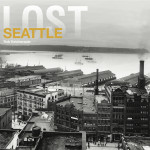C A Doty
CHAUNCEY ALBERT DOTY, of Seattle, was born in Bradford County, Pennsylvania, July 14, 1859, son of Floyd A. and Lillis (Johnson) Doty. On his father’s side he is a descendant of Edward Doty, a passenger of the “Mayflower,” and through his mother he comes from original Scottish stock. When he was nine years old the family removed to Marshalltown, Iowa. Owing to the of illness his father he was obliged to leave school at the age of fifteen and obtain employment, becoming from that time the principal support of the family of eight persons (which consisted of father and mother, four sisters, a brother, and himself). He began work with the Central Iowa Railway in Marshalltown, and, utilizing his spare time in learning telegraphy, at the end of a year and a half was engaged as an operator at Gilman, Iowa. In that occupation he continued for some three years in Iowa, when he went south, and during the next three years was employed by the Missouri, Kansas, and Texas Railroad at various places in the Indian Territory and Texas. He then became connected with the signal service corps of the United States army, serving at stations along the Texas frontier until the fall of 1880. The years of Mr. Doty’s residence in the southwest coincided with the extermination of the buffalo and the last of the Indian difficulties.
Resigning from the signal service, he resumed railroading, at which he was engaged in Colorado and Texas until i886. In January of that year he accepted an offer from E. P. Cowen, who had the exclusive contract for furnishing ties and piling for the Gould system, and was given responsible charge of the territory from Little Rock, Arkansas, to St. Louis. Under his supervision half a million white oak ties monthly were produced from the forests of Arkansas and Missouri. After the completion of the contract he spent eighteen months operating a large sawmill for the Cowen interests. In consequence of ill health he left that position, and, putting into execution a long cherished desire to go farther west, came to Puget Sound, arriving in Tacoma on the 5th of October, 1889.
Mr. Doty’s first employment in Washington was as agent for the Northern Pacific Railroad at Kalama, a capacity in which he served until 1895. After a few months Kalama he began to take an active interest in the possibilities of the fish industry, which was then in its infancy, and which, on account of the crude methods in vogue, was practically restricted to the local field in its transactions. Applying himself to an investigation of the subject of markets and other practical details, he became convinced that the proper energy would bring substantial rewards and embarked in the business at first in a small way but with steadily increasing operations. The result was the formation of the Doty Fish Company, which is still in existence, doing a large volume of business both in the United States and abroad. This concern (one of the pioneers of its kind on the Columbia River) he developed while still with the railway company and the resulting trade contributed materially both to the enlargement of the railway business and the general prosperity of the community.
With two associates, H. Orchard and J. P. Atkin (then and still a banker of Kalama), he planned and built, in 1896-7, the water-works supplying the towns of Castle Rock, Washington, Tillamook, Oregon, and Marshfield, Oregon. These three partners were also the pioneers of developing the wire-wound wooden stave waterpipe and the first on the Pacific coast to manufacture it. Their failure to patent the process resulted in manufacturing operations by many others in what is now a large separate industry. In 1899 he started a sawmill in the woods a mile and a half west of Dryad on the South Bend branch of the Northern Pacific Railroad. Upon that site the town of Doty, Washington has since grown up—a thriving community of some seven hundred inhabitants, with electric light, waterworks, and fine church and school buildings. From a small beginning Mr. Doty developed his mill to a daily capacity of one hundred and twenty-five thousand feet of lumber and three hundred thousand shingles, a thoroughly equipped logging railway ten miles long being operated in connection with it. He disposed of his interests in Doty, Washington, in August, 1910. During the past three years his home has been in Seattle.
In 1904 he joined with a number of others in forming the Kalama Electric Light and Power Company, which developed the three thousand horsepower of the Kalama Falls. This company supplies light and power to Kalama and Woodland in the state of Washington, and, by means of a cable under the river, to Rainier, Oregon. The towns of Castle Rock and Kelso, Washington, are soon to receive current.
He is a president of the Starr Orchard Company (organized in 1910), which derives its water from the Methow River ditch, eight miles in length, in Okanogan County. The company now has one hundred acres of apple orchards “under water,” to which three hundred acres will be added in the spring of 1911. He is president of the Castle Rock Water Company, is interested in various other industrial undertakings, and is vice-president of the Mercantile Bank of Seattle. His connections with organizations include the Masons (in which he is a Knight Templar and Shriner and has received the thirty-second degree), the Knights of Pythias, and the Elks; and he is a member of the Arctic Seattle Athletic, and Metropolitan clubs.
Mr. Doty married, first, December 13, 1883, Hattit VicRoy, of Oskaloosa, Iowa, and of that union there is one son, Floyd A. He married, second, November 20, 1891 Minnie Gruber, daughter of John L. Gruber, a merchant and postmaster at Winlock, Washington. They have three children, Walter L., Charlotte M., and Katherine M.
Posted by Rob Ketcherside at July 17, 2005 2:58 PM